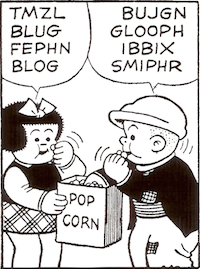I like Levenger, sort of. It's a source for beautiful furniture, reasonably-priced fountain pens, and dazzling (and, yes, unaffordable) watches. I'm sitting at a Levenger carrel as I'm typing.
The problem with Levenger though is its tendency to turn any human endeavor into a sham--a mere exercise in conspicuous consumption. Consider its new product line: Bookography™, an array of reading-journals and accessories.
The company slogan--"Tools for Serious Readers"--looks pretty ironic in light of Bookography™. "It's never too late--or too early," the catalogue encourages us, "to start keeping a journal of the books you've read and are planning to read, and the truths and pleasure you take from them. We've found [sic] a new and satisfying way to do so, which we call your Bookography."
Oh, my very own Bookography™.
The Bookography™ Journal must be seen to be appreciated (by clicking here). It's a ring-binder with removable pages ($20, Junior; $24, Letter). An optional leather jacket will cost you $78 or $94. There's also Electronic Bookography™ ($50) and a Deluxe Electronic version ($84, for books, "music," and "video"). A scanner ($14) is available to gather online information via barcodes (I'm not kidding).
Each book is allotted a single page, which travels from section to section of the Journal. The page begins in the "List of Candidates" (books you want to read). Note that a true list would gather many titles on a single page. With Bookography™, you've already devoted a page to a single book you might never read (you get only fifty pages, with "refills" available).
In an ideal narrative, the page travels to the "Library of Candidates" (books you've "acquired"), then to the books you're "Now Reading" (with a section for "Castaways," "proof of your sampling enough good titles"), then to "Après Reading" (while you review the book "a few times at lengthening intervals"), and, finally, to your "Living Library" ("most pages will live here").
The fill-in-the-blanks layout of the book page itself reminds me of the pages my children were filling out not too long ago in elementary school. To wit:
"My reason for wanting to read it": One of the imaginary people whose handwriting graces Levenger catalogue photos has written, in ladylike script, "Sounds like fascinating history."
"Notes as I go": Three lines, with an arrow to the back of the page.
"My review notes": Another three lines, another arrow.
(And here I'm really reminded of elementary school: "Use the back if you need more space!")
"I'll recommend this book to," "I'll buy this book for," "This book led me to these books," "This book led me to these experiences or interests": These prompts are each allotted a single line. (All that's missing is "I liked this book because.") There's no arrow next to "This book led me to these experiences or interests." Levenger customers must be pretty darn succinct (or else they write more about their experiences in their leather-bound journals).
Here's a different approach to keeping a reading-journal. Keep a list of books you might want to read (an index card, text file, or Palm memo will do just fine). Buy a notebook. Buy or borrow some books. Read. Write.
It surprised me at first that the Levenger catalogue gives away the whole idea of Bookography™ by showing the page format in a large, easy-to-read photograph. There's nothing to stop someone who really wants to do a Bookography™ Journal from typing out a reasonable facsimile, printing copies, punching holes, and getting started. But Levenger must know its customers well enough to know that what they're really after is the feeling that comes with possessing this, uhh, tool. A tool for a serious reader? A tool for a serious dilettante, I'm afraid.
An aside: For several years I asked students in my classes to keep reading-journals--tremendously rewarding for them to write, tremendously exhausting for me to read. The minimum entry was 400 words per class (in college classes meeting three times a week). I graded journals on length, relevance, and completeness. A finished journal typically filled one or more two-inch looseleaf binders. That's what I call a tool for a serious reader.


